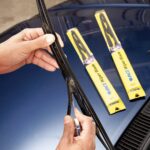Dealing with a malfunctioning car AC system, especially during hot weather, is frustrating. One common culprit is a refrigerant leak. Identifying and fixing these leaks promptly is crucial for restoring your car’s cooling efficiency and preventing further damage. This guide will walk you through the process of finding and repairing AC leaks in your car, ensuring you can keep your cool on the road.
Many car owners mistakenly believe that moisture in the AC system causes the suction line to frost up. In reality, the opposite occurs. Moisture within the system can freeze at the orifice tube or expansion valve, obstructing refrigerant flow. This blockage halts cooling, and while the ice melts and cooling might temporarily resume, the cycle repeats, leading to intermittent cooling issues.
While moisture problems can affect your AC, evaporator core leaks are increasingly prevalent, particularly in systems using high-pressure R134a refrigerant, compared to older R12 systems. However, several components are more susceptible to leaks. Condensers are frequently damaged by road debris, causing punctures or cracks. O-ring failures at various connection points are also common leak sources. Compressor failures, while significant, are not always the primary cause of refrigerant loss. Since stationary components like condensers and evaporators endure constant pressure stress, their seals and connections often degrade over time, leading to leaks.
When adding refrigerant, it’s important to understand your vehicle’s system. Some vehicles utilize a receiver/dryer on the low-pressure side. If your R134a connection is upstream of the accumulator, you can safely introduce refrigerant in liquid form (can upside down), as the accumulator is designed to handle liquid refrigerant and prevent it from reaching the compressor. However, if you’re unsure about your system configuration, always keep the refrigerant can upright when the compressor is running to avoid potential compressor damage from liquid refrigerant entering the suction line, which it cannot compress. Overfilling the system can also lead to serious issues, potentially damaging the compressor. Newer vehicles often require significantly less refrigerant than older models, so consulting your vehicle’s specifications is crucial.
For accurate diagnosis and repair, consulting a dedicated car AC repair manual is highly recommended. These manuals provide detailed information on proper pressure readings for both the suction and high-pressure lines. However, the most effective approach is to have the existing refrigerant professionally reclaimed, followed by system evacuation using a vacuum pump for at least 30 minutes. This process effectively removes moisture and air from the system. Finally, recharge the system with the precise amount of refrigerant specified for your vehicle, eliminating guesswork and ensuring optimal performance and longevity of your AC system.


